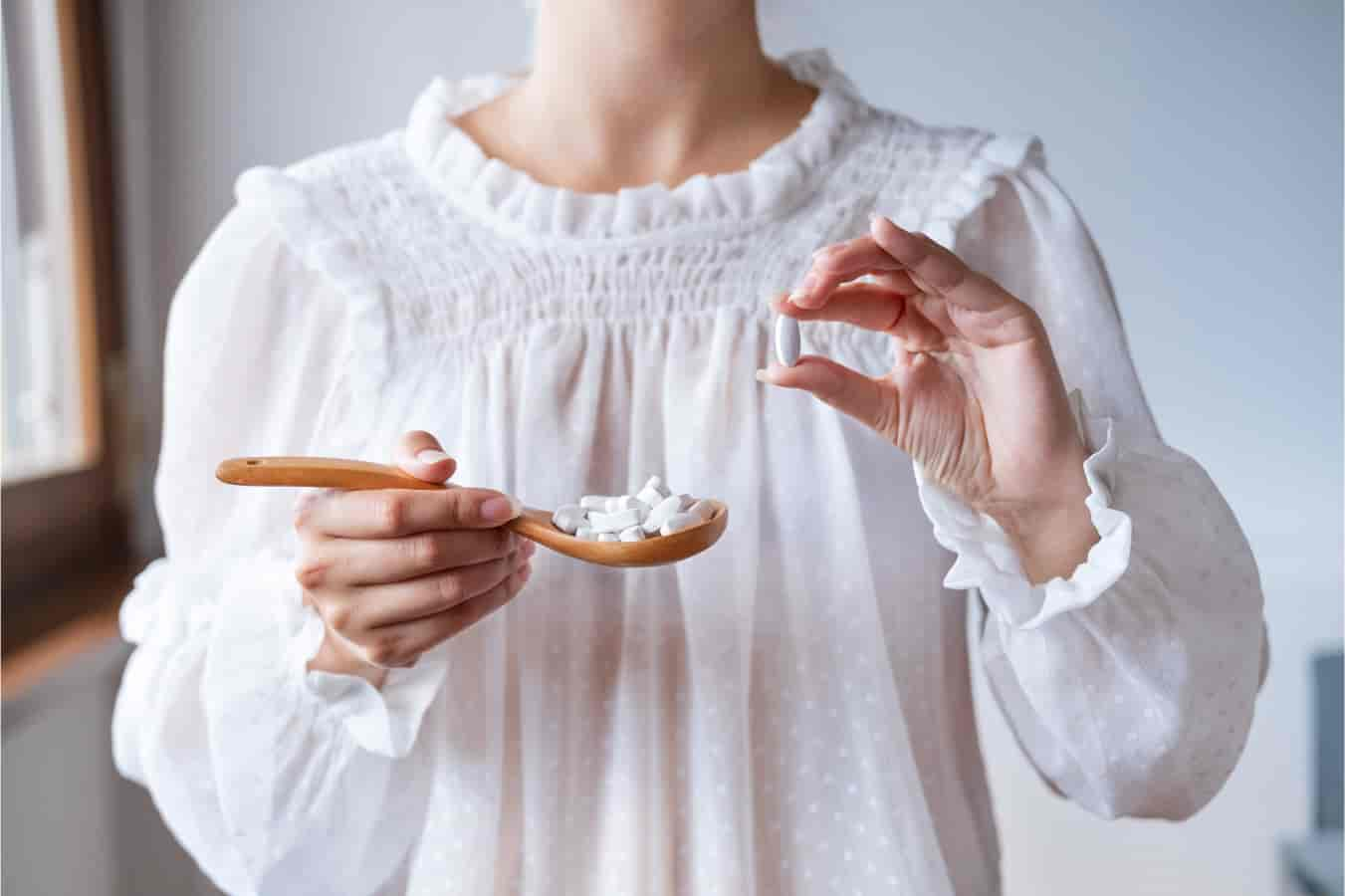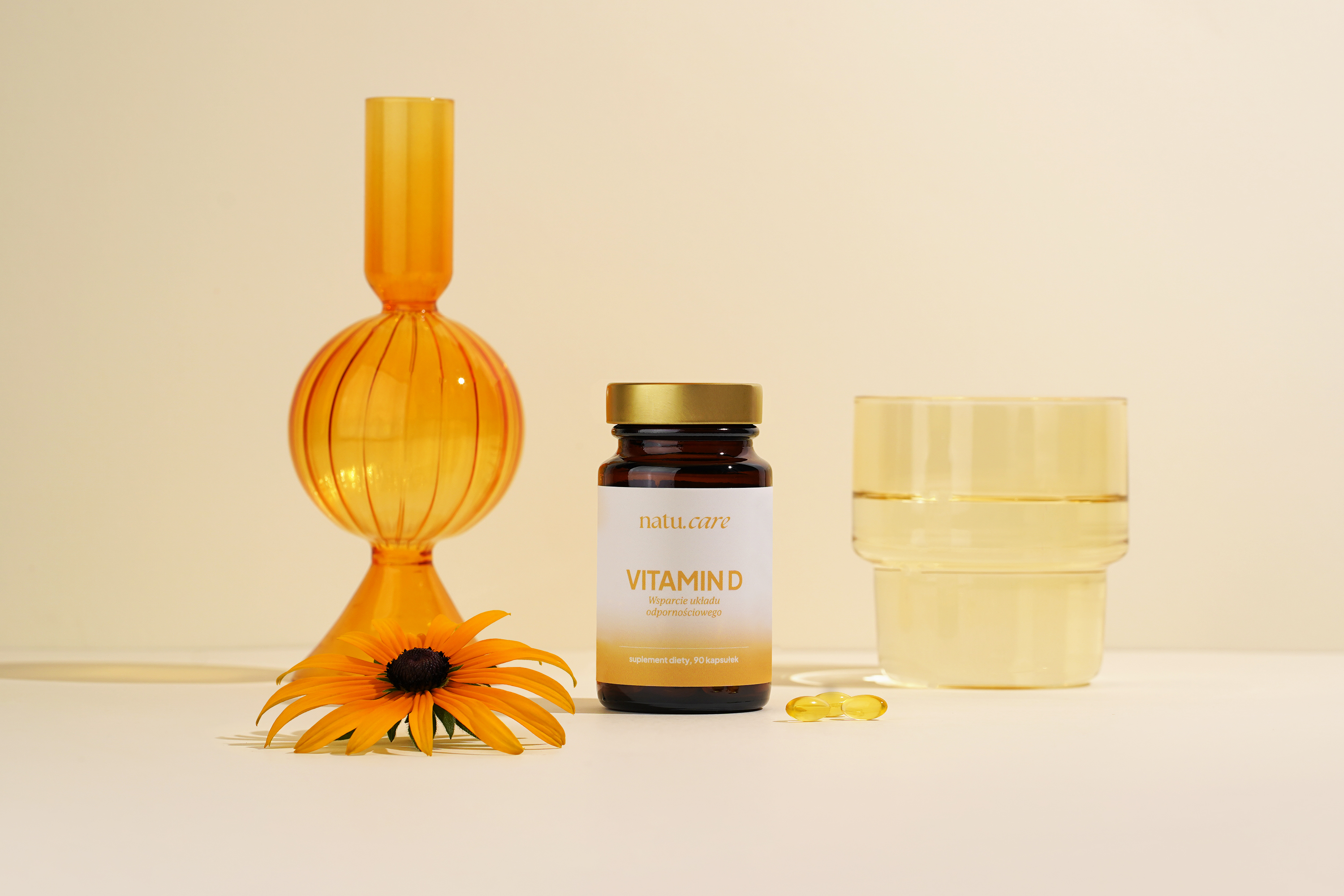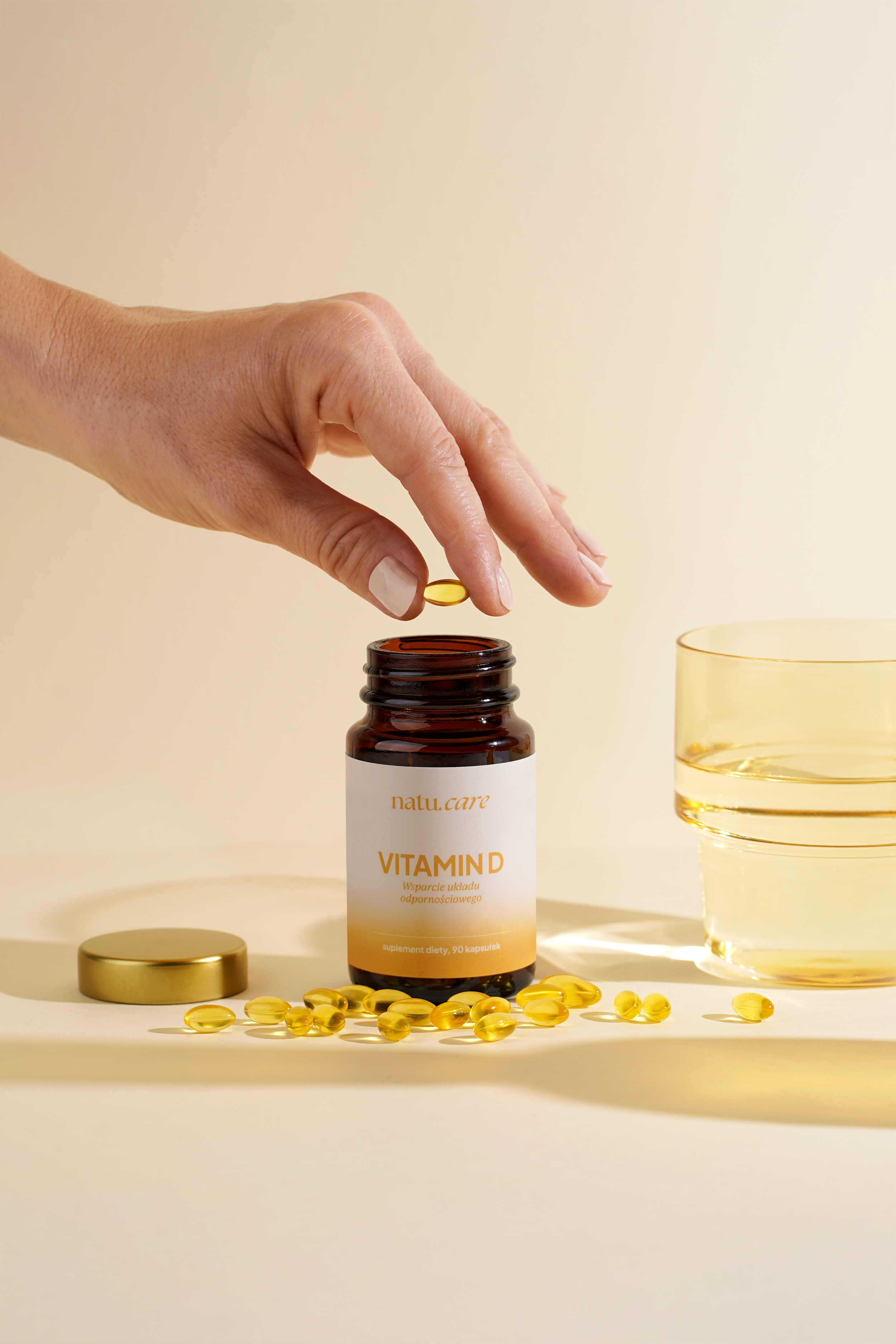Vitamin K - where it occurs, what it helps, deficiency symptoms
Vitamin K is involved in blood clotting and regulates the body's calcium balance. The daily requirement of vitamin K is covered by intestinal flora bacteria and a diet rich in green vegetables.


Learn more about our editorial process
.

Learn more about our editorial process
.

Learn more about our editorial process
.
Why you can trust us
Articles on Natu.Care are written based on scientific research, data from government websites and other reliable sources. The texts are written in cooperation with doctors, nutritionists and other health and beauty experts. Articles are reviewed before publication and during significant updates.
.Learn more about our editorial process
.Information about advertisements
Content on Natu.Care may contain links to products from the sale of which we may receive a commission. When creating content, we adhere to high editorial standards and take care to be objective about the products discussed. The presence of affiliate links is not dictated by our partners, and we select the products we review ourselves completely independently.
.Learn more about our terms and Conditions
.Did you know the role that ... chickens played in the discovery of vitamin K? Many of them sacrificed their health so that today we understand what vitamin K is and how important it is for our bodies.
In this article, I will introduce you to the somewhat surprising history of the discovery of vitamin K and, together with Dr. Witold Tomaszewski, M.D., I will introduce you to the functions, best sources and symptoms of deficiency of this vitamin. After reading the article, you will become better acquainted with the "coagulation vitamin" and develop a taste for... salad.
.
Description of contents:
.- The curious circumstances of the discovery of vitamin K .
- Vitamin K properties .
- What vitamin K helps .
- Where is vitamin K found? Best sources
- Vitamin K deficiency - symptoms .
- Effects of vitamin K deficiency .
- Vitamin K excess - is it possible .
- Daily requirement of vitamin K .
- Contraindications and precautions .
- Summary .

Zobacz, co dla Twojego zdrowia może zrobić Natu.Care Witamina D 2000 IU. -15% z kodem BLOG15
Natu.Care Witamina D 2000 IU
Natu.Care Witamina D 2000 IU wspiera prawidłowe działanie układu odpornościowego, utrzymanie zdrowych kości i zębów oraz utrzymanie prawidłowych funkcji serca, nerek i układu mięśniowego.
Sprawdź cenę
Świetny produkt, tabletki są małe i wygodne do połknięcia. Plus za wysoką jakość!Joanna
See also:
- Vitamin K2 [action + deficiency symptoms] .
- Vitamin D3 K2 [whether you need to combine + expert opinion]
- Vitamin D3 drops [ranking + use + expert opinion]
- Vitamin K2 [properties + occurrence] .
- Best vitamin D3 [ranking + expert opinion] .
- Vitamin D deficiency [symptoms + treatment] .
- Vitamin D [dosage + standards and recommendations] .
- Vitamin D overdose [symptoms + effects + what to do] .
- What is vitamin D? [sources, table, examples] .
- Maximum dose of vitamin D [what + expert opinion] .
Interesting circumstances of the discovery of vitamin K
.
In 1929, Danish scientist Henrik Dam studied and the process of cholesterol metabolism in the body by feeding chickens a fat-free diet. After a few weeks, the animals began to suffer from bleeding in the subcutaneous tissue, muscles or organs.
Adding cholesterol to the diet did not help, so Dam postulated that - in addition to fat - there must be another compound in the diet to prevent bleeding. Haemorrhages in chickens regressed when alfalfa, spinach or cabbage were included in the diet (they have a high vitamin K content).
Following further research, he found a factor in hemp seeds that prevented bleeding and decided to call it the clotting vitamin. In German, it was labelled "coagulation vitamin" (coagulation) and so the new vitamin was given the letter K.
The new vitamin was named vitamin K.
Vitamin K - properties
.
It is one of the 4 vitamins fat-solubleand, along with the vitamins A, D and E. Vitamin K is actually a group of 3 organic chemical compoundsand.
.
In this group are:
.
- .
- Vitamin K1 (phylloquinone) .
It is synthesised by plants - found in green leafy vegetablesand. It is the main source of vitamin K in the diet of Europeansand.
- .
- Vitamin K2 (menaquinone) .
It is mainly found in meat, cheese and eggs. It is also produced by the bacteria that make up our intestinal flora of the digestive system. The synthesis of this vitamin by the microorganisms found in the jejunum and ileum, covers a significant part of the daily requirement for vitamin K.
- .
- Vitamin K3 (menadione) .
Synthetic form of vitamin K, acting as a provitamin (a chemical compound that is converted into a vitamin in the body under the influence of enzymes or sunlight). It is used as a haemostatic drug.
What does vitamin K help with?
.
Vitamin K affects several important processes in our body.
- .
- Helps the cardiovascular system by strengthening blood vessel wallsand.
- Participates in the formation of proteins needed for proper clotting of blood.
- Along with osteocalcin, has effects on the production of healthy bone tissue .
- Helps the calcification of bone tissue by the skeletal system, participating in the formation of bone tissue .
- Strengthens the immune system .
Scientists are also looking at the likely properties of vitamin Kand. The work is ongoing, and the researchers are particularly interested in the role of vitamin K:
- as a protective factor in the development of liver cancer and in reducing the risk of death in patients with cirrhosis and cancers originating from hepatocytes (the cells that make up the liver), .
- in its ability to increase the sensitivity of target tissues to insulin, .
- in reducing the risk of the onset and development of coronary heart disease. .
Where is vitamin K found? Best sources
.
Daily vitamin and mineral requirements are best met with a balanced and varied diet. Find out where you can find the most vitamin K - compose a meal that is tasty and rich in this vitamin.
Productsand rich in vitamin K1 (values given per 100 g):
. . . . . . . . . . . . . . . . . . . . . . . . . . . . . . . . . . . . . . . . . . . . . . . . . . .
| Product | Content | |
| dried basil | 1714.5 µg | |
| dried sage | 1714.5 µg | 1714.5 µg |
| dried thyme | 1714.5 µg | 1714.5 µg |
| fresh parsley | 1640 µg | |
| dried coriander leaf | 1359.5 µg | |
| raw chard | 830 µg | |
| raw dandelion | 778.4 µg | |
| cooked Chinese cabbage | 623.2µg | |
| dried marjoram | 621.7µg | |
| dried oregano | 621.7 µg | 621.7 µg |
| cooked mustard | 592.7 µg | |
| raw cress | 541.9 µg | |
| cooked spinach | 540.7 µg | |
| cooked turnip | 518.9 µg | |
| cooked beetroot | 484 µg | |
| cooked kale | 418.5 µg | |
| chives | 212.7 µg | |
| cooked Brussels sprouts | 193.5 µg | |
| soybean oil | 183.9 µg | |
| mayonnaise | 163 µg | |
| broccoli | 141.1 µg | |
| green lettuce | 126.3 µg | |
| cooked cabbage | 108.7 µg | |
| raw arugula | 108.6 µg | |
| margarine | 101.3 µg |
It is worth adding spices to your dishes not only to enhance their flavour and aroma - they are also real vitamin K bombs.
Best sources of vitamin K2and (values quoted per 100 g):
. . . . . . . . . . . . . . . . . . . . . . . . . . . . . . . .
| Product | Value | |
| natto (a Japanese dish made from fermented soybeans) | 998 µg | |
| soft cheeses (e.g. mozzarella, feta) | 506 µg | |
| mould cheese | 440 µg | |
| goose liver | 369 µg | |
| hard cheeses (e.g. gouda, edam) | hard cheese | 282 µg |
| beef liver | 106 µg | |
| hen's egg yolk | 67-192 µg | |
| carb | 63 µg | |
| pepperoni | 41.7 µg | |
| whole milk | 38.1 µg | |
| turkey sausage | 36.6 µg | 36.6 µg |
| chicken meat | 35.7 µg | |
| bacon | 35 µg | |
| frankfurter turkey | 31.2 µg | |
| salami | 28 µg |
From the whole combination, you can compose a very tasty and valuable salad rich in vitamin K1 and K2. Do you have an idea? Leave it to me in a comment below the article, I'd be happy to try it.
Vitamin K deficiency - symptoms
.
Vitamin K deficiency is rare in adult individualsand. The daily requirement is largely covered by the synthesis of vitamin K2 by the intestinal microflora, and the rest is supplemented by vitamin K1 supplied with food.
Deficiency usually results from disorders in the process digestion or absorptionand in the gastrointestinal tract and in adults may manifest as:
- prolonged wound healing time, .
- haemorrhages, .
- easy formation of bruises, .
- disorders of the bowel,
- frequent diarrhoea, and
- frequent diarrhoea,
- reduced immune function,
- diarrhoea.
- lower immune function,
- heavy menstrual periods
- abundant menstruation in women, .
Infants are at risk of vitamin K deficiency due to incompletely formed intestinal flora and low vitamin K content in breast milk.
Nevertheless, infants are at risk of vitamin K deficiency.
Vitamin K2 deficiency in infants can be manifested by:and
- bleeding from the site where the umbilical cord was removed, .
- bleeding in the skin, nose, gastrointestinal tract or elsewhere,
- bloods from the skin, nose, gastrointestinal tract or other areas.
- bleeding from the penis (if the child has been circumcised), .
- increased bleeding into the brain, .
The Polish Neonatal Society recommends vitamin K supplementation for infantsand. All newborns should receive vitamin K (usually by injection) within the first 5 hours of life.
.
Effects of vitamin K deficiency
.
Unmedicated vitamin K deficiency can lead to:
- disorders of blood clottingand, .
- increased risk of cardiovascular disease ,
- osteoporosis ,
- vascular calcification (calcification),
- haemorrhages , .
- hepatitis , .
Remember - vitamin K deficiency is rare. It's good to be aware of the symptoms of deficiency, but if you take care of a varied diet and don't have problems with your digestive function - don't worry about a deficiency of this vitamin.
Vitamin K excess - is it possible?
.
Vitamin K overdose occurs rarelyand. Symptoms of overdose reported in the literature include: feeling hot, excessive sweating, breakdown of red blood cells and symptoms of haemolytic anaemia.
The toxicity of vitamin K usually involves menadione, a synthetic vitamin K3and.
Despite the fact that no toxic dose has been reported in the scientific literature, patients should not take excessive amounts of vitamin K. Instead, they should be encouraged to eat a healthy, balanced diet with green leafy vegetables rather than supplementing with this vitamin..
 .
.
Dr. n. med. Witold Tomaszewski
.Daily vitamin K requirements
.
Because of insufficient evidence regarding the function, absorption and occurrence of menaquinones (vitamin K2) in humans, standards have been set only for phylloquinone (vitamin K1).
Standards for vitamin Kand for Poland, set at adequate intake (AI)*
.
|
Group, gender, age . |
µg vitamin K (phylloquinone)/person/day . |
|
Infants .0-6 months 7-11 months |
5 8.5 |
|
Children 1-3 years 4-6 years 7-9 years |
15 20 25 |
|
Boys 10-12 years 13-15 years 16-18 years |
40 50 65 |
|
Girls 10-12 years 13-15 years 16-18 years |
40 50 55 |
|
Males >19 years |
55 |
|
Women, pregnant and breastfeeding women >19 years |
55 |
*AI (Adequate Intake) is a dietary recommendation used when there is insufficient data to calculate average intakeand.
See also articles on health:
.
- Blood tests [how often to do them + how to prepare] .
- Cortisol testing [standards + price] .
- Thyroid tests [which ones to perform + norms + results]
In 2020. The Dietary Supplements Panel of the Sanitary and Epidemiological Council has set the maximum amount of vitamin K in a daily recommended serving of a dietary supplement for adults at 200 µg.
 .
.
Dr. n. med. Witold Tomaszewski
.Contraindications and precautions
.
The use of vitamin K requires precautionsand u:
- newborns, .
- patients with renal impairment, .
- patients with hereditary hypoprothrombinemia (prothrombin - blood clotting factor deficiency), .
- patients with excessive anticoagulation, .
- patients with hypersensitivity to vitamin K, .
Pregnant and breastfeeding women should consult a physician before supplementation.
See also other articles on vitamins and minerals:
.
- Vitamin B12 deficiency [causes + symptoms + treatment] .
- Vitamin D deficiency [symptoms + treatment] .
- Potassium [deficiency + norm + what it's in]
- Zinc [properties + deficiency + excess] .
- Iron [properties + sources + deficiency]
- Selenium [properties + dosage + supplementation] .
- Iodine [properties + dosage + deficiency symptoms] .
Do you know any other interesting facts about vitamin K? Share them in the comments. I'd love to read about them while I'm eating my greens.
Summary
.
From this article, remember (and surprise your friends with how vitamin K was discovered!):
- Vitamin K is made up of three compounds: K1 (phylloquinone), K2 (menaquinone) and K3 (menadione).
- Vitamin K is fat-soluble. .
- Daily requirements are met through the bacteria of the intestinal flora of the digestive system and from a diet rich in green vegetables.
- Vitamin K supports the cardiovascular and skeletal systems and plays an important role in the blood clotting process.
- Vitamin K deficiency and excess are rare. .
FAQ
.What does vitamin K do?
.Vitamin K is a group of compounds (including vitamin K2) that is essential for normal blood clotting, as well as bone health and cardiovascular function.
Vitamin K is responsible for, among other things:
- blood clotting processes - vitamin K deficiency leads to disorders and increases the risk of bleeding; .
- regulation of bone mineralisation - activates proteins that bind calcium in bones; .
- heart health - affects the ability to break down fats in the body; .
Where is vitamin K found and what is it most abundant in?
.Vitamin K naturally occurs mainly in two forms - K1 and K2. Vitamin K1 is synthesised by plants, while K2 is synthesised by the bacteria Bacillus subtilis natto, which participates in natural fermentation processes.
Vitamin K can be found in products such as:
- green leafy vegetables - e.g. spinach, kale, broccoli, lettuce, cabbage, parsley;
- fruits - e.g. spinach, kale, broccoli, lettuce, cabbage, parsley
- fruits - e.g. avocados, kiwi, grapes, strawberries, blueberries; .
- meat - e.g. turkey, goose liver, chicken, beef liver; .
- nobody - e.g. cheeses (soft, hard, mouldy), whole milk; .
- fermented products - e.g. kefir, yoghurt, kimchi, tempeh; .
From when to give vitamin K to newborns and infants?
.Vitamin K does not pass easily through the mother's placenta, so babies are born with low levels of vitamin K in their blood. Furthermore, the intestinal bacteria that synthesise it are not yet fully developed. It is therefore advisable to give vitamin K in the first hours after birth - either by injection, orally or by intravenous infusion. Subsequent doses should be given according to the doctor's recommendations during the first few months of life - there is not enough vitamin K in breast milk.
What are the symptoms of vitamin K deficiency?
.The most important symptoms and effects of vitamin K deficiency are:
.- disorders of blood clotting;
- a reduced risk of bleeding.
- increased risk of bleeding; .
- weakening of muscles; .
- decreased bone density;
- increased risk of bleeding;
- increased risk of bleeding
- impaired functioning of the liver; .
- increased risk of cardiovascular disease; .
If you observe any symptoms, be sure to consult your doctor, who will order detailed diagnostic tests and order appropriate treatment.
How to supplement vitamin K?
.The most common ways to supplement vitamin K deficiency are:
.- a balanced diet - include green leafy vegetables, legumes (beans, peas), fatty fish, cheese, poultry liver and fermented foods (yoghurt, kefir, kimchi);
- a balanced diet.
- supplementation - you can choose tablets, capsules or drops; .
- probiotics - especially those with Bacillus subtilis natto bacteria in the formulation; .
What is the best form of vitamin K?
.Each form of vitamin K has its own benefits for your body's health. The right vitamin K should be chosen based on your needs and clinical situation.
- Vitamin K1 is essential for blood clotting and is often found in leafy green vegetables.
- Vitamin K1 is essential for blood clotting and is often found in leafy green vegetables.
- Vitamin K2 - particularly its MK7 form - is widely used in supplementation. It has beneficial effects on bone health, regulates the transport of calcium in the body, and may help prevent osteoporosis.
Always work with your doctor or nutritionist to choose the specific form and method of supplementation.
.Are potassium and vitamin K the same thing?
.No, potassium and vitamin K are two different substances and are not the same. Among other things, potassium is essential for maintaining electrolyte balance, regulates blood pressure and is involved in muscle function. Find out more about it in the article: Potassium in the body - properties, deficiency, sources.
..
Sources
.See all
.Adequate intake | EFSA. (n.d.). Retrieved 21 March 2023, from https://www.efsa.europa.eu/en/glossary/adequate-intake
Ahmadraji, F., & Shatalebi, M. A. (2015). Evaluation of the clinical efficacy and safety of an eye counter pad containing caffeine and vitamin K in emulsified Emu oil base. Advanced Biomedical Research, 4(1), 10. https://doi.org/10.4103/2277-9175.148292
Bell, R. G. (1978). Metabolism of vitamin K and prothrombin synthesis: Anticoagulants and the vitamin K--epoxide cycle. Federation Proceedings, 37(12), 2599-2604. https://pubmed.ncbi.nlm.nih.gov/359368/
Blood disease-Vitamin K deficiency | Britannica. (n.d.). Retrieved March 21, 2023, from https://www.britannica.com/science/blood-disease/Vitamin-K-deficiency
Boston, 677 Huntington Avenue, & Ma 02115 +1495-1000 (2012, Sep 18). Vitamin K. The Nutrition Source. https://www.hsph.harvard.edu/nutritionsource/vitamin-k/
Brown, P. C., Dulik, D. M., & Jones§, T. W. (1991). The toxicity of menadione (2-methyl-1,4-naphthoquinone) and two thioether conjugates studied with isolated renal epithelial cells. Archives of Biochemistry and Biophysics, 285(1), 187-196. https://doi.org/10.1016/0003-9861(91)90348-M
Conly, J. M., & Stein, K. (1992). The production of menaquinones (vitamin K2) by intestinal bacteria and their role in maintaining coagulation homeostasis. Progress in Food & Nutrition Science, 16(4), 307-343. https://pubmed.ncbi.nlm.nih.gov/1492156/
DiNicolantonio, J. J., Bhutani, J., & O'Keefe, J. H. (2015). The health benefits of vitamin K. Open Heart, 2(1), e000300. https://doi.org/10.1136/openhrt-2015-000300
Eden, R. E., & Coviello, J. M. (2023). Vitamin K Deficiency. In StatPearls. StatPearls Publishing. http://www.ncbi.nlm.nih.gov/books/NBK536983/
.Effect of vitamin K2 on progression of atherosclerosis and vascular calcification in nondialyzed patients with chronic kidney disease stages 3-5. (n.d.). https://doi.org/10.20452/pamw.3041
.Full article: Helicobacter pylori antibiotic eradication coupled with a chemically defined diet in INS-GAS mice triggers dysbiosis and vitamin K deficiency resulting in gastric haemorrhage. (n.d.). Retrieved March 21, 2023, from https://www.tandfonline.com/doi/full/10.1080/19490976.2019.1710092
Gijsbers, B. L. M. G., Jie, K.-S. G., & Vermeer, C. (1996). Effect of food composition on vitamin K absorption in human volunteers. British Journal of Nutrition, 76(2), 223-229. https://doi.org/10.1079/BJN19960027
Griffin, R. M. (n.d.). Do You Get Enough Vitamin K? WebMD. Retrieved March 21, 2023, from https://www.webmd.com/vitamins-and-supplements/supplement-guide-vitamin-k
Growing evidence of vitamin K benefits for heart health. (n.d.). ScienceDaily. Retrieved March 21, 2023, from https://www.sciencedaily.com/releases/2021/08/210809144115.htm
Halder, M., Petsophonsakul, P., Akbulut, A. C., Pavlic, A., Bohan, F., Anderson, E., Maresz, K., Kramann, R., & Schurgers, L. (2019). Vitamin K: Double Bonds beyond Coagulation Insights into Differences between Vitamin K1 and K2 in Health and Disease. International Journal of Molecular Sciences, 20(4), Article 4. https://doi.org/10.3390/ijms20040896
Hamidi, M. S., & Cheung, A. M. (2014). Vitamin K and musculoskeletal health in postmenopausal women. Molecular Nutrition & Food Research, 58(8), 1647-1657. https://doi.org/10.1002/mnfr.201300950
Health, N. R. C. (U.S.) C. on D. and. (1989). Fat-Soluble Vitamins. In Diet and Health: Implications for Reducing Chronic Disease Risk. National Academies Press (US). https://www.ncbi.nlm.nih.gov/books/NBK218749/
.Imbrescia, K., & Moszczynski, Z. (2023). Vitamin K. In StatPearls. StatPearls Publishing. http://www.ncbi.nlm.nih.gov/books/NBK551578/
Ishida, Y. (2008). [Vitamin K2]. Clinical Calcium, 18(10), 1476-1482.
Jarosza, M., Rychlik, E., Stoś, K., & Charzewska, J. (n.d.). Nutrition standards for the Polish population and their application. https://www.pzh.gov.pl/wp-content/uploads/2020/12/Normy_zywienia_2020web-1.pdf
Koshihara, Y., & Hoshi, K. (1997). Vitamin K2 Enhances Osteocalcin Accumulation in the Extracellular Matrix of Human Osteoblasts In Vitro. Journal of Bone and Mineral Research, 12(3), 431-438. https://doi.org/10.1359/jbmr.1997.12.3.431
Kubo, Y., Rooney, A. P., Tsukakoshi, Y., Nakagawa, R., Hasegawa, H., & Kimura, K. (2011). Phylogenetic Analysis of Bacillus subtilis Strains Applicable to Natto (Fermented Soybean) Production. Applied and Environmental Microbiology, 77(18), 6463-6469. https://doi.org/10.1128/AEM.00448-11
Maresz, K. (2015). Proper Calcium Use: Vitamin K2 as a Promoter of Bone and Cardiovascular Health. Integrative Medicine: A Clinician's Journal, 14(1), 34-39. https://www.ncbi.nlm.nih.gov/pmc/articles/PMC4566462/
Martinez, C., Wallenhorst, C., Rietbrock, S., & Freedman, B. (2020). Ischemic Stroke and Transient Ischemic Attack Risk Following Vitamin K Antagonist Cessation in Newly Diagnosed Atrial Fibrillation: A Cohort Study. Journal of the American Heart Association, 9(2), e014376. https://doi.org/10.1161/JAHA.119.014376
Mizuta, T., Ozaki, I., Eguchi, Y., Yasutake, T., Kawazoe, S., Fujimoto, K., & Yamamoto, K. (2006). The effect of menatetrenone, a vitamin K2 analog, on disease recurrence and survival in patients with hepatocellular carcinoma after curative treatment. Cancer, 106(4), 867-872. https://doi.org/10.1002/cncr.21667
Myneni, V. D., & Mezey, E. (2018). Immunomodulatory effect of vitamin K2: Implications for bone health. Oral diseases, 24(1-2), 67-71. https://doi.org/10.1111/odi.12759
Nowak, J. K., Grzybowska-Chlebowczyk, U., Landowski, P., Szaflarska-Poplawska, A., Klincewicz, B., Adamczak, D., Banasiewicz, T., Plawski, A., & Walkowiak, J. (2014). Prevalence and correlates of vitamin K deficiency in children with inflammatory bowel disease. Scientific Reports, 4(1), Article 1. https://doi.org/10.1038/srep04768
Office of Dietary Supplements-Vitamin K. (n.d.-a). Retrieved March 21, 2023, from https://ods.od.nih.gov/factsheets/VitaminK-HealthProfessional/
Office of Dietary Supplements-Vitamin K. (n.d.-b). Retrieved March 21, 2023, from https://ods.od.nih.gov/factsheets/VitaminK-HealthProfessional/
Sato, T., Inaba, N., & Yamashita, T. (2020). MK-7 and Its Effects on Bone Quality and Strength. Nutrients, 12(4), Article 4. https://doi.org/10.3390/nu12040965
Schwalfenberg, G. K. (2017). Vitamins K1 and K2: The Emerging Group of Vitamins Required for Human Health. Journal of Nutrition and Metabolism, 2017, e6254836. https://doi.org/10.1155/2017/6254836
The health benefits of vitamin K | Open Heart. (n.d.). Retrieved March 21, 2023, from https://openheart.bmj.com/content/2/1/e000300
Theuwissen, E., Smit, E., & Vermeer, C. (2012). The Role of Vitamin K in Soft-Tissue Calcification. Advances in Nutrition, 3(2), 166-173. https://doi.org/10.3945/an.111.001628
Tsugawa, N., & Shiraki, M. (2020). Vitamin K Nutrition and Bone Health. Nutrients, 12(7), Article 7. https://doi.org/10.3390/nu12071909
Urano, A., Hotta, M., Ohwada, R., & Araki, M. (2015). Vitamin K deficiency evaluated by serum levels of undercarboxylated osteocalcin in patients with anorexia nervosa with bone loss. Clinical Nutrition, 34(3), 443-448. https://doi.org/10.1016/j.clnu.2014.04.016
Vermeer, C. V. (2012). Vitamin K: The effect on health beyond coagulation - an overview. Food & Nutrition Research, 56(1), 5329. https://doi.org/10.3402/fnr.v56i0.5329
Vitamin K Deficiency-Nutritional Disorders. (n.d.). MSD Manual Professional Edition. Retrieved March 21, 2023, from https://www.msdmanuals.com/professional/nutritional-disorders/vitamin-deficiency,-dependency,-and-toxicity/vitamin-k-deficiency
VITAMIN K: Overview, Uses, Side Effects, Precautions, Interactions, Dosing and Reviews. (n.d.). Retrieved March 21, 2023, from https://www.webmd.com/vitamins/ai/ingredientmono-983/vitamin-k
Vitamin K in the prevention of bleeding resulting from deficiency in newborns. (n.d.). Retrieved March 21, 2023, from http://www.neonatology.edu.pl/index.php?option=com_content&view=article&id=116:vitamin-k-in-preventing-bleeding-resulting-from-its-deficiency-in-newborns&catid=8&Itemid=103
.
Editorials
Meet the team


Fact-checker
Agata Jach is in charge of verifying quoted sources and checking that published content is truthful.
![Vitamin B12 - where it occurs in the diet and in products [table].](https://cdn-resources.natu.care/uploads/1/balanced_diet_nutrition_healthy_eating_concept_food_sources_rich_vitamin_b12_cobalamin_kitchen_table_1_b84f75bda2.jpg)
Find out where vitamin B12 is found and which products will provide you with it.

Vitamin PP also known as niacin or vitamin B3 supports the proper functioning of the body.
![What is NMN? Effects, effects, side effects [supplements].](https://cdn-resources.natu.care/uploads/1/science_background_with_molecule_atom_abstract_structure_science_medical_background_3d_illustration_1_a5ec4d9cec.jpg)
Everything you want to know about NMN: properties, effects, safety and expert opinions.
